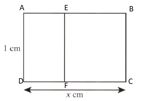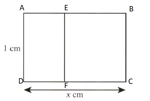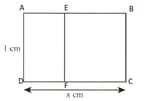Karen Morrison and Nick Hamshaw Solutions for Exercise 3: Exercise 22.3
Karen Morrison Mathematics Solutions for Exercise - Karen Morrison and Nick Hamshaw Solutions for Exercise 3: Exercise 22.3
Attempt the free practice questions from Exercise 3: Exercise 22.3 with hints and solutions to strengthen your understanding. Cambridge IGCSE® Mathematics Core and Extended Coursebook Second Edition solutions are prepared by Experienced Embibe Experts.
Questions from Karen Morrison and Nick Hamshaw Solutions for Exercise 3: Exercise 22.3 with Hints & Solutions
The diagram given below shows a rectangle that has been divided into a square and a smaller rectangle.The smaller rectangle is similar to larger one.Solve the equation,,giving the answer to decimal places.

The diagram given below shows a rectangle that has been divided into a square and a smaller rectangle.The smaller rectangle is similar to larger one.Solve the equation,,giving the answer to decimal places.Explain why one of the solution does not work in this case.

The diagram given below shows a rectangle that has been divided into a square and a smaller rectangle.The smaller rectangle is similar to larger one.Solve the equation,,giving the answer to decimal places.Find the perimeter of the rectangle.

The product of three consecutive integers is times smallest of the three integers.Find the two possible sets of integers that will satisfy this condition.
The square of a number is more than times the number. Find the two possible numbers for which this is true.
A rectangle has sides of length and . If the perimeter of the rectangle is and the area of the rectangle is ,use algebra to find the dimensions of the rectangle.
A ball is thrown from a building and falls in after how many seconds has the ball fallen
A stone is thrown up into the air from ground level. If the height of the stone is , for how long will the stone be more than above the ground.
